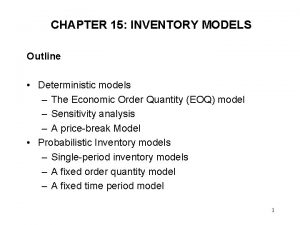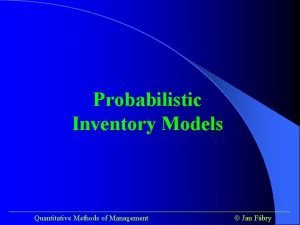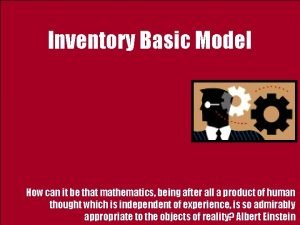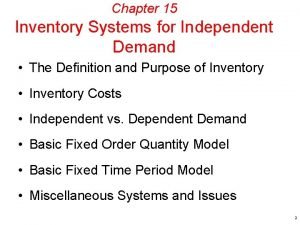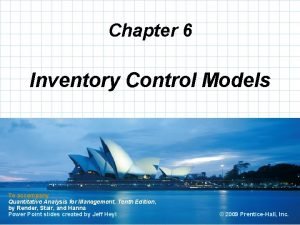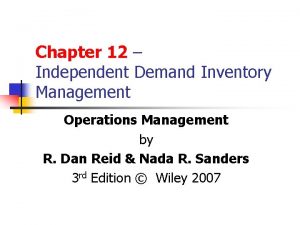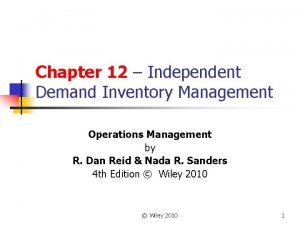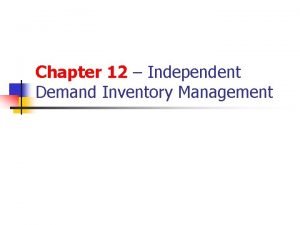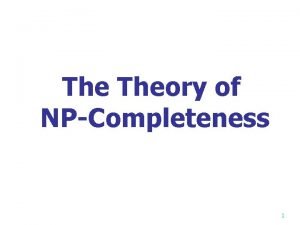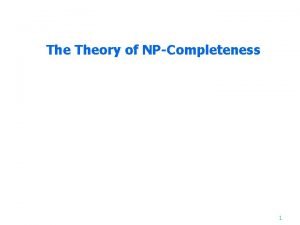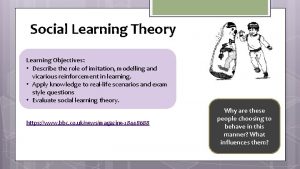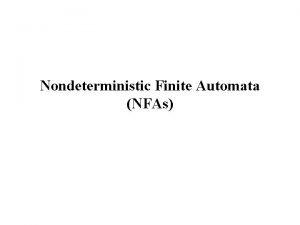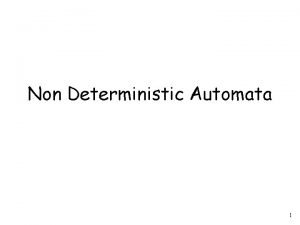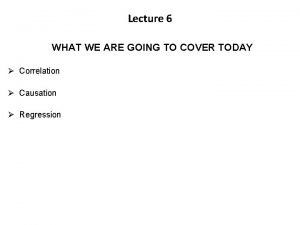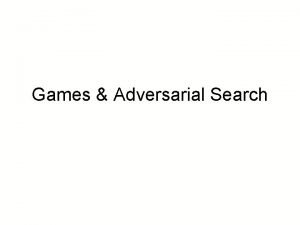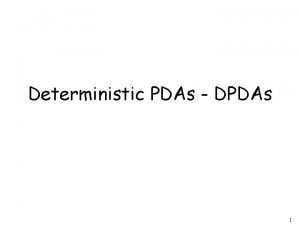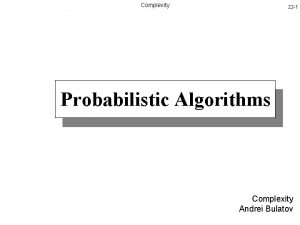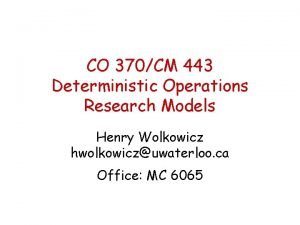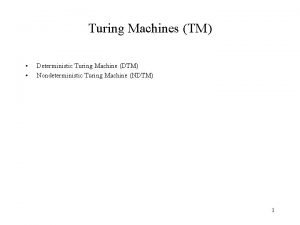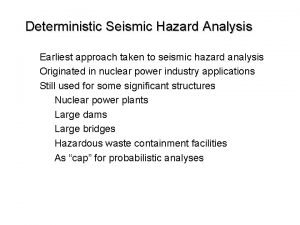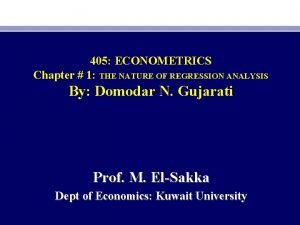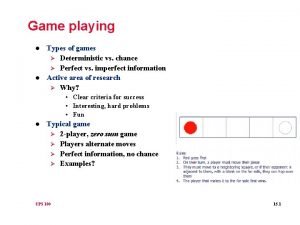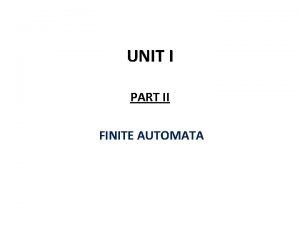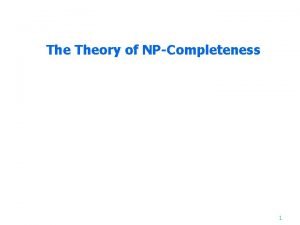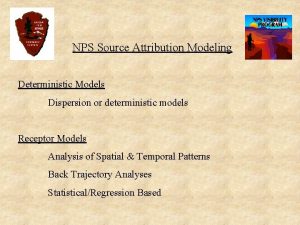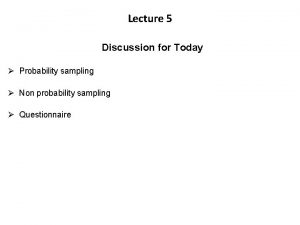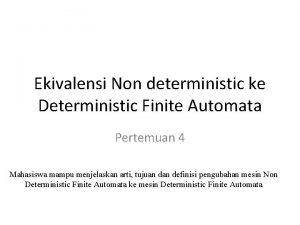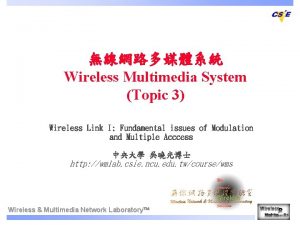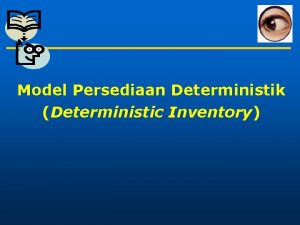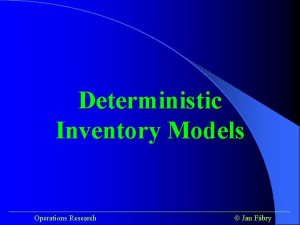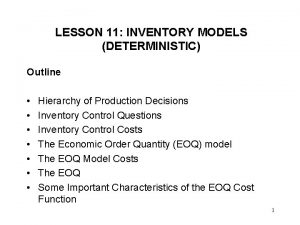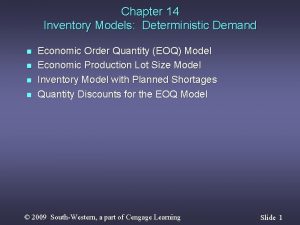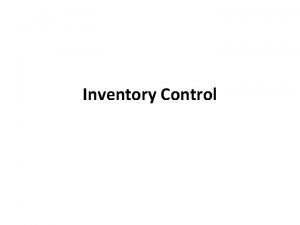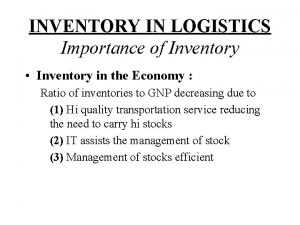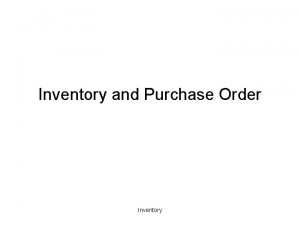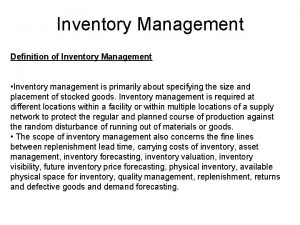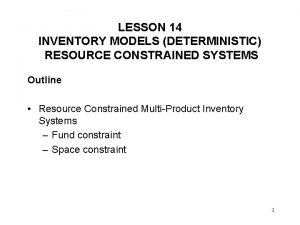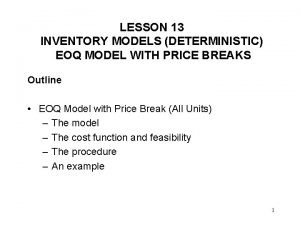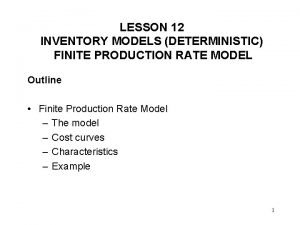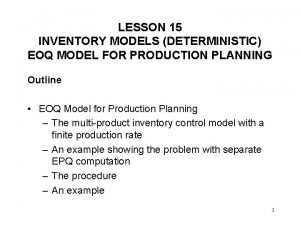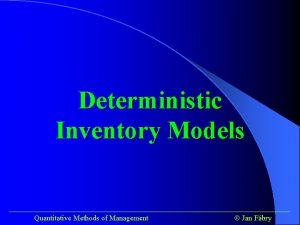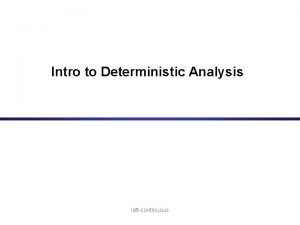CHAPTER 15 INVENTORY MODELS Outline Deterministic models The































































- Slides: 63

CHAPTER 15: INVENTORY MODELS Outline • Deterministic models – The Economic Order Quantity (EOQ) model – Sensitivity analysis – A price-break Model • Probabilistic Inventory models – Single-period inventory models – A fixed order quantity model – A fixed time period model 1

Inventory Decision Issues • • • Demand of various items Money tied up in the inventory Cost of storage space Insurance expense - risk of fire, theft, damage Order processing costs Loss of profit due to stock outs 2

Inventory Decision Questions How Much? When? 3

THE EOQ MODEL Demand rate Inventory Level Order qty, Q Reorder point, R 0 Lead time Order Placed Received Lead Time time Order Placed Received 4

The EOQ Model Cost Curves Annual cost ($) Slope = 0 Total Cost Minimum total cost Holding Cost = HQ/2 Ordering Cost = SD/Q Optimal order Q* Order Quantity, Q 5

EOQ Cost Model D - annual demand Q - order quantity S - cost of placing order H - annual per-unit holding cost Ordering cost = SD/Q Holding cost = HQ/2 Total cost = SD/Q + HQ/2 6

Example 1: R & B beverage company has a soft drink product that has a constant annual demand rate of 3600 cases. A case of the soft drink costs R & B $3. Ordering costs are $20 per order and holding costs are 25% of the value of the inventory. R & B has 250 working days per year, and the lead time is 5 days. Identify the following aspects of the inventory policy: a. Economic order quantity 7

b. Reorder point c. Cycle time 8

d. Total annual cost 9

SENSITIVITY ANALYSIS 10

Some Important Characteristics of the EOQ Cost Function • At EOQ, the annual holding cost is the same as annual ordering cost. 11

Some Important Characteristics of the EOQ Cost Function • The total cost curve is flat near EOQ – So, the total cost does not change much with a slight change in the order quantity (see the total cost curve and the example on sensitivity) 12

EOQ WITH PRICE BREAKS • Assumptions – Demand occurs at a constant rate of D items per year. – Ordering Cost is $S per order. – Holding Cost is $H = $Ci. I per item in inventory per year (note holding cost is based on the cost of the item, Ci). – Purchase Cost is $C 1 per item if the quantity ordered is between 0 and x 1, $C 2 if the order quantity is between x 1 and x 2, etc. – Delivery time (lead time) is constant. 13

EOQ with Price Breaks Formulae • Formulae – Optimal order quantity: the procedure for determining Q* will be demonstrated – Number of orders per year: D/Q* – Time between orders (cycle time): Q*/D years – Total annual cost: [(1/2)Q*H] + [DS/Q*] + DC (holding + ordering + purchase) 14

EOQ with Price Breaks Procedure Steps 1. Determine the largest (cheapest) feasible EOQ value: The most efficient way to do this is to compute the EOQ for the lowest price first, and continue with the next higher price. Stop when the first EOQ value is feasible (that is, within the correct interval). 2. Compare the costs: Compare the value of the average annual cost at the largest feasible EOQ and at all of the price breakpoints that are greater than the largest feasible EOQ. The optimal Q is the point at which the average annual cost is a minimum. 15

Example 2: Nick's Camera Shop carries Zodiac instant print film. The film normally costs Nick $3. 20 per roll, and he sells it for $5. 25. Nick's average sales are 21 rolls per week. His annual inventory holding cost rate is 25% and it costs Nick $20 to place an order with Zodiac. If Zodiac offers a 7% discount on orders of 400 rolls or more and a 10% discount for 900 rolls or more, determine Nick's optimal order quantity. 16

D = 21(52) = 1092; H =. 25(Ci); S = 20 Step 1: Determine the largest (cheapest) feasible EOQ 17

Step 2: Compare the costs Compute the total cost for the most economical, feasible order quantity in each price category for which a was computed. 18

PROBABILISTIC MODELS Outline • Probabilistic inventory models • Single- and multi- period models • A single-period model with uniform distribution of demand • A single-period model with normal distribution of demand 19

Probabilistic Inventory Models • The demand is not known. Demand characteristics such as mean, standard deviation and the distribution of demand may be known. • Stockout cost: The cost associated with a loss of sales when demand cannot be met. For example, if an item is purchased at $1. 50 and sold at $3. 00, the loss of profit is $3. 00 -1. 50 = $1. 50 for each unit of demand not fulfilled. 20

Single- and Multi- Period Models • The classification applies to the probabilistic demand case • In a single-period model, the items unsold at the end of the period is not carried over to the next period. The unsold items, however, may have some salvage values. • In a multi-period model, all the items unsold at the end of one period are available in the next period. • In the single-period model and in some of the multiperiod models, there remains only one question to answer: how much to order. 21

SINGLE-PERIOD MODEL • Computer that will be obsolete before the next order • Perishable product • Seasonal products such as bathing suits, winter coats, etc. • Newspaper and magazine 22

Trade-offs in a Single-Period Models Loss resulting from the items unsold ML= Purchase price - Salvage value Profit resulting from the items sold MP= Selling price - Purchase price Trade-off Given costs of overestimating/underestimating demand the probabilities of various demand sizes how many units will be ordered? 23

Consider an order quantity Q Let P = probability of selling all the Q units = probability (demand Q) Then, (1 -P) = probability of not selling all the Q units We continue to increase the order size so long as 24

Decision Rule: Order maximum quantity Q such that where P = probability (demand Q) 25

Text Problem 21, Chapter 15: Demand for cookies: Demand Probability of Demand 1, 800 dozen 0. 05 2, 000 0. 10 2, 200 0. 20 2, 400 0. 30 2, 600 0. 20 2, 800 0. 10 3, 000 0, 05 Selling price=$0. 69, cost=$0. 49, salvage value=$0. 29 a. Construct a table showing the profits or losses for each possible quantity b. What is the optimal number of cookies to make? c. Solve the problem by marginal analysis. 26

Sample computation for order quantity = 2200: Expected number sold=1800(0. 05)+2000(0. 10)+2200(0. 85) =2160 Revenue from sold items=2160(0. 69)=$1490. 4 Revenue from unsold items=(2200 -2160)(0. 29)=$11. 6 Total revenue=1490. 4+11. 6=$1502 Cost=2200(0. 49)=$1078 27 Profit=1502 -1078=$424

28

Solution by marginal analysis: Order maximum quantity, Q such that Demand, Q Probability(demand) Probability(demand Q), p 29

Demand Characteristics Suppose that the historical sales data shows: Quantity 14 15 16 17 18 19 20 No. Days sold 1 2 3 6 9 11 12 Quantity 21 22 23 24 25 26 No. Days sold 11 9 6 3 2 1 30

Demand Characteristics Mean = 20 Standard deviation = 2. 49 31

Demand Characteristics 32

Example 3: The J&B Card Shop sells calendars. The once-a -year order for each year’s calendar arrives in September. The calendars cost $1. 50 and J&B sells them for $3 each. At the end of July, J&B reduces the calendar price to $1 and can sell all the surplus calendars at this price. How many calendars should J&B order if the September-to-July demand can be approximated by a. uniform distribution between 150 and 850 33

Solution to Example 3: Loss resulting from the items unsold ML= Purchase price - Salvage value = Profit resulting from the items sold MP= Selling price - Purchase price = 34

P = Now, find the Q so that P(demand Q) = Q* = 35

Example 4: The J&B Card Shop sells calendars. The once-a -year order for each year’s calendar arrives in September. The calendars cost $1. 50 and J&B sells them for $3 each. At the end of July, J&B reduces the calendar price to $1 and can sell all the surplus calendars at this price. How many calendars should J&B order if the September-to-July demand can be approximated by b. normal distribution with = 500 and =120. 36

Solution to Example 4: ML=$0. 50, MP=$1. 50 (see example 3) P = Now, find the Q so that P = 37

We need z corresponding to area = From Appendix D, p. 780 z= Hence, Q* = + z = 38

Example 5: A retail outlet sells a seasonal product for $10 per unit. The cost of the product is $8 per unit. All units not sold during the regular season are sold for half the retail price in an end-of-season clearance sale. Assume that the demand for the product is normally distributed with = 500 and = 100. a. What is the recommended order quantity? b. What is the probability of a stockout? c. To keep customers happy and returning to the store later, the owner feels that stockouts should be avoided if at all possible. What is your recommended quantity if the owner is willing to tolerate a 0. 15 probability of stockout? d. Using your answer to part c, what is the goodwill cost you are assigning to a stockout? 39

Solution to Example 5: a. Selling price=$10, Purchase price=$8 Salvage value=10/2=$5 MP =10 - 8 = $2, ML = 8 -10/2 = $3 Order maximum quantity, Q such that Now, find the Q so that P = 0. 6 or, area (2)+area (3) = 0. 6 or, area (2) = 0. 6 -0. 5=0. 10 40

Find z for area = 0. 10 from the standard normal table given in Appendix D, p. 736 z = 0. 25 for area = 0. 0987, z = 0. 26 for area = 0. 1025 So, z = 0. 255 (take -ve, as P = 0. 6 >0. 5) for area = 0. 10 So, Q*= +z =500+(-0. 255)(100)=474. 5 units. b. P(stockout) = P(demand Q) = P = 0. 6 c. P(stockout)=Area(3)=0. 15 From Appendix D, find z for Area (2) = 0. 5 -0. 15=0. 35 41

z = 1. 03 for area = 0. 3485 z = 1. 04 for area = 0. 3508 So, z = 1. 035 for area = 0. 35 So, Q*= +z =500+(1. 035)(100)=603. 5 units. d. P=P(demand Q)=P(stockout)=0. 15 For a goodwill cost of g MP =10 - 8+g = 2+g, ML = 8 -10/2 = 3 Now, solve g in p = Hence, g=$15. 42

MULTI-PERIOD MODELS Outline • A fixed order quantity model • A fixed time period model 43

A FIXED ORDER QUANTITY MODEL Purchase-order can be placed at any time On-hand inventory count is known always Lead time for a high speed modem is two weeks and it has the following sales history in the last 25 weeks: Quantity/Week Frequency 75 -80 1 70 -75 3 65 -70 9 60 -65 8 55 -60 4 Will you order now if number of items on hand is: a. 200 b. 150 c. 100 44

A Fixed Order Quantity Model • The same quantity, Q is ordered when inventory on hand reaches a reorder point, R 45

A Fixed Order Quantity Model • An order quantity of EOQ works well • If demand is constant, reorder point is the same as the demand during the lead time. • If demand is uncertain, reorder point is usually set above the expected demand during the lead time • Reorder point = Expected demand + Safety stock 46

Quantity Safety Stock Expected demand during lead time Reorder Point Safety stock Time Lead Time 47

Trade-Off with Safety Stock • Safety Stock - Stock held in excess of expected demand to protect against stockout during lead time. Safety stock Holding cost Stockouts 48

Acceptable Level of Stockout Ask the manager!! Acceptable level of stockout reflects management’s tolerance A related term is service level. Example: if 20 orders are placed in a year and management can tolerate 1 stockout in a year, acceptable level of stockout = 1/20 = 0. 05 = 5% and the service level = 1 - 0. 05 = 0. 95. 49

Computation of Safety Stock 50

Example 6: B&S Novelty and Craft Shop sells a variety of quality handmade items to tourists. B&S will sell 300 handmade carved miniature replicas of a Colonial soldier each year, but the demand pattern during the year is uncertain. The replicas sell for $20 each, and B&S uses a 15% annual inventory holding cost rate. Ordering costs are $5 per order, and demand during the lead time follows a normal probability distribution with = 15 and = 6. a. What is the recommended order quantity? b. If B&S is willing to accept a stockout roughly twice a year, what reorder point would you recommend? What is the probability that B&S will have a stockout in any one order-cycle? c. What are the inventory holding and ordering costs? 51

A FIXED TIME PERIOD MODEL • Purchase-order is issued at a fixed interval of time A distributor of soft drinks prepares a purchase order for beverages once a week on every Monday. The beverages are received on Thursdays (the lead time is three days). Choose a method for finding order quantity for the distributor: a. Mean demand for 7 days + safety stock b. Mean demand for 10 days + safety stock c. Mean demand for 10 days + safety stock — inventory on hand 52

Replenishment Level and Safety Stock • Replenishment level, M = Desired inventory to cover review period & lead time = Expected demand during review period & lead time + Safety stock • Order quantity, Q = M - H H = inventory on hand • Trade-off with safety stock Safety stock Holding cost Stockouts 53

The Fixed Time Period Model 54

Computation of Replenishment Level 55

Comparison Between P and Q models 56

Example 7: Statewide Auto parts uses a 4 -week periodicreview system to reorder parts for its inventory stock. A 1 week lead time is required to fill the order. Demand for one particular part during the 5 -week replenishment period is normally distributed with a mean of 18 units and a standard deviation of 6 units. a. At a particular periodic review, 8 units are in inventory. The parts manager places an order for 16 units. What is the probability that this part will have a stockout before an order that is placed at the next 4 -week review period arrives? B. Assume that the company is willing to tolerate a 2. 5% chance of stockout associated with a replenishment decision. How many parts should the manager have ordered in part (a)? What is the replenishment level for the 4 -week periodic review system? 57

Example 8: Rose Office Supplies, Inc. , uses a 2 -week periodic review for its store inventory. Mean and standard deviation of weekly sales are 16 and 5 respectively. The lead time is 3 days. The mean and standard deviation of lead-time demand are 8 and 3. 5 respectively. A. What is the mean and standard deviation of demand during the review period plus the lead-time period? B. Assuming that the demand has a normal probability distribution, what is the replenishment level that will provide an expected stockout rate of one per year? C. If there are 18 notebooks in the inventory, how many notebooks should be ordered? 58

Example 9: Foster Drugs, Inc. , handles a variety of health and beauty products. A particular hair conditioner product costs Foster Drugs $2. 95 per unit. The annual holding cost rate is 20%. A fixed-quantity model recommends an order quantity of 300 units per order. a. Lead time is one week and the lead-time demand is normally distributed with a mean of 150 units and a standard deviation of 40 units. What is the reorder point if the firm is willing to tolerate a 1% chance of stockout on any one cycle? b. What safety stock and annual safety stock cost are associated with your recommendation in part (a)? c. The fixed-quantity model requires a continuous-review system. Management is considering making a transition to a fixed-period system in an attempt to coordinate ordering 59

for many of its products. The demand during the proposed two -week review period and the one-week lead-time period is normally distributed with a mean of 450 units and a standard deviation of 70 units. What is the recommended replenishment level for this periodic-review system if the firm is willing to tolerate the same 1% chance of stockout associated with any replenishment decision? d. What safety stock and annual safety stock cost are associated with your recommendation in part ( c )? e. Compare your answers to parts (b) and (d). The company is seriously considering the fixed-period system. Would you support the decision? Explain. f. Would you tend to favor the continuous-review system for more expensive items? For example, assume that the product in the above example sold for $295 per unit. Explain. 60

Text Problem 5, Chapter 15: Charlie’s Pizza orders all of its pepperoni, olives, anchovies, and mozzarella cheese to be shipped directly from Italy. An American distributor stops by every four weeks to take orders. Because the orders are shipped directly from Italy, they take three weeks to arrive. Charlie’s Pizza uses an average of 150 pounds of pepperoni each week, with a standard deviation of 30 pounds. Charlie’s prides itself on offering only the best-quality ingredients and a high level of service, so it wants to ensure a 98 percent probability of not stocking out on pepperoni. Assume that the sales representative just walked in the door and there are currently 500 pounds of pepperoni in the walkin cooler. How many pounds of pepperoni would you order? 61

Text Problem 10, Chapter 15: The annual demand for a product is 15, 600 units. The weekly demand is 300 units with a standard deviation of 90 units. The cost to place an order is $31. 20, and the time from ordering to receipt is four weeks. The annual inventory carrying cost is $0. 10 per unit. Find the reorder point necessary to provide a 98 percent service probability. Suppose the production manager is asked to reduce the safety stock of this item by 50 percent. If she does so, what will the new service probability be? 62

Reading and Exercises • Chapter 15 pp. 586 -609 • Exercises: Chapter end problems 4, 5, 6, 10, 12, 14 and 20 Examples 5, 8 and 9 63
 Inventory modeling
Inventory modeling Deterministic and probabilistic inventory models
Deterministic and probabilistic inventory models Deterministic and stochastic inventory models
Deterministic and stochastic inventory models Quote sandwich format
Quote sandwich format Probabilistic models and safety stock
Probabilistic models and safety stock Most inventory models attempt to minimize
Most inventory models attempt to minimize Independent demand inventory
Independent demand inventory Independent demand meaning
Independent demand meaning Inventory control model
Inventory control model Inventory models for independent demand
Inventory models for independent demand Independent demand
Independent demand Independent demand inventory management
Independent demand inventory management Non-deterministic algorithm
Non-deterministic algorithm Non deterministic algorithm for sorting
Non deterministic algorithm for sorting Max clique problem
Max clique problem Social learning theory assumptions
Social learning theory assumptions Non-deterministic algorithm
Non-deterministic algorithm Nfa non deterministic finite automata
Nfa non deterministic finite automata Nfa to dfa
Nfa to dfa Statistical vs deterministic relationship
Statistical vs deterministic relationship Deterministic games examples
Deterministic games examples Deterministic seismic hazard analysis
Deterministic seismic hazard analysis Deterministic pda example
Deterministic pda example Andrei bulatov
Andrei bulatov Deterministic operations research
Deterministic operations research Seventuple
Seventuple Known vs unknown environment
Known vs unknown environment Deterministic definition
Deterministic definition Statistical versus deterministic relationship
Statistical versus deterministic relationship Deterministic lockstep
Deterministic lockstep Deterministic game
Deterministic game Deterministic cross device tracking
Deterministic cross device tracking Moore to mealy conversion
Moore to mealy conversion Non deterministic algorithm for sorting
Non deterministic algorithm for sorting Deterministic attribution
Deterministic attribution Statistical versus deterministic relationship
Statistical versus deterministic relationship Ekivalensi
Ekivalensi A deterministic turing machine is: *
A deterministic turing machine is: * Deterministic
Deterministic State yang merupakan non-deterministic ditandai dengan
State yang merupakan non-deterministic ditandai dengan Deterministic finite state automata
Deterministic finite state automata Modals and semi modals difference
Modals and semi modals difference Hình ảnh bộ gõ cơ thể búng tay
Hình ảnh bộ gõ cơ thể búng tay Slidetodoc
Slidetodoc Bổ thể
Bổ thể Tỉ lệ cơ thể trẻ em
Tỉ lệ cơ thể trẻ em Gấu đi như thế nào
Gấu đi như thế nào Chụp phim tư thế worms-breton
Chụp phim tư thế worms-breton Chúa yêu trần thế alleluia
Chúa yêu trần thế alleluia Các môn thể thao bắt đầu bằng tiếng đua
Các môn thể thao bắt đầu bằng tiếng đua Thế nào là hệ số cao nhất
Thế nào là hệ số cao nhất Các châu lục và đại dương trên thế giới
Các châu lục và đại dương trên thế giới Công của trọng lực
Công của trọng lực Trời xanh đây là của chúng ta thể thơ
Trời xanh đây là của chúng ta thể thơ Cách giải mật thư tọa độ
Cách giải mật thư tọa độ 101012 bằng
101012 bằng Phản ứng thế ankan
Phản ứng thế ankan Các châu lục và đại dương trên thế giới
Các châu lục và đại dương trên thế giới Thơ thất ngôn tứ tuyệt đường luật
Thơ thất ngôn tứ tuyệt đường luật Quá trình desamine hóa có thể tạo ra
Quá trình desamine hóa có thể tạo ra Một số thể thơ truyền thống
Một số thể thơ truyền thống Cái miệng nó xinh thế
Cái miệng nó xinh thế Vẽ hình chiếu vuông góc của vật thể sau
Vẽ hình chiếu vuông góc của vật thể sau Nguyên nhân của sự mỏi cơ sinh 8
Nguyên nhân của sự mỏi cơ sinh 8

